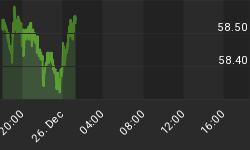
SPECIAL GUEST: Richard Duncan
26 Minutes, 25 Slides

Richard Duncan has served as global head of investment strategy at ABN AMRO Asset Management in London, worked as a financial sector specialist for the World Bank in Washington D.C., and headed equity research departments for James Capel Securities and Salomon Brothers in Bangkok. He also worked as a consultant for the IMF in Thailand during the Asia Crisis. Richard has appeared frequently on CNBC, CNN, BBC and Bloomberg Television, as well as on BBC World Service Radio. He is also the author of three books on the global economic crisis. The Dollar Crisis: Causes, Consequences, Cures (2003); The Corruption of Capitalism (2009); and, The New Depression: The Breakdown Of The Paper Money Economy (2012).
Richard believes we no longer have Capitalism driving economic growth but rather Creditism. In the past, economic growth was driven by saving and investment. It doesn't work that way any more. Now, the economy is driven by credit creation and consumption. Capitalism has evolved into Creditism! As a result credit growth today drives economic growth, liquidity determines the direction of asset prices and the government attempts to control both to make sure that the economy continues to grow.
Understanding this new dynamic is critical to making investment decisions within the current Fiat Currency regime environment. In this video Richard Duncan outlines what he believes the Federal Reserve will be forced to do in 2014 and 2015 to avoid as US and potential global recession. More Quantitative Easing is on the horizon.
The 2% Credit Growth Floor
Since the end of WWII, every time the US has fallen below 2% credit growth the US experienced a recession and prompted a shift in Monetary Policy. The tenuous global economic environment couldn't handle a US recession and the Federal Reserve is acutely aware of this and will do everything in its power to forestall such a possibility.

The Macro Watch Liquidity Gauge

$2.3 Trillion in Liquidity Required
Richard analytically illustrates why the Federal Reserve must add an additional $500B to $1T in liquidity over current "Taper" estimates. Investors shouldn't bet on QE Ending in 2014!
Based on the current Fed Taper schedule, Liquidity will become tight in the third quarter of 2014 and there will be a significant liquidity drain beginning in the fourth quarter. If the Fed sticks with this schedule, interest rates are likely to rise by mid-2014. Higher interest rates would cause a fall in property prices, stock prices and net worth, which would cause the economy to fall back into recession. To prevent that, the Fed is likely to create more fiat money through QE than its taper schedule suggests.
This is must listening for serious investors.

Sign up for your FREE 2014 THESIS
THE GLOBALIZATION TRAP
Available January 2014
CHECK OUT OUR EXTENSIVE LIBRARY OF VIDEOS
VIDEO LIBRARY
YouTube Channel
20-40 Minute Shows with 25-50 Supporting Slides















